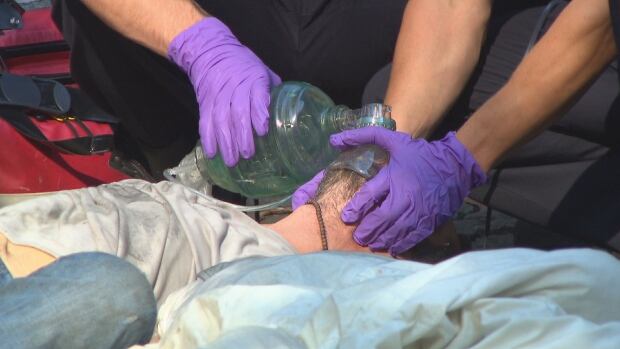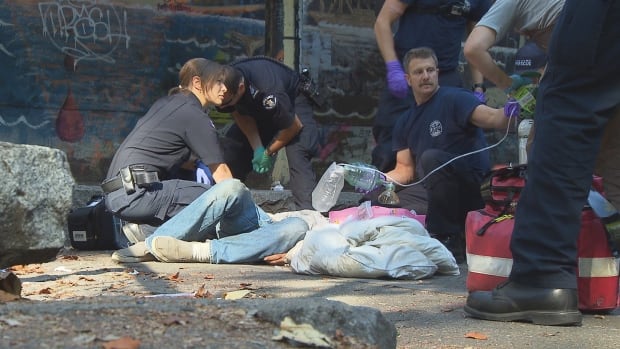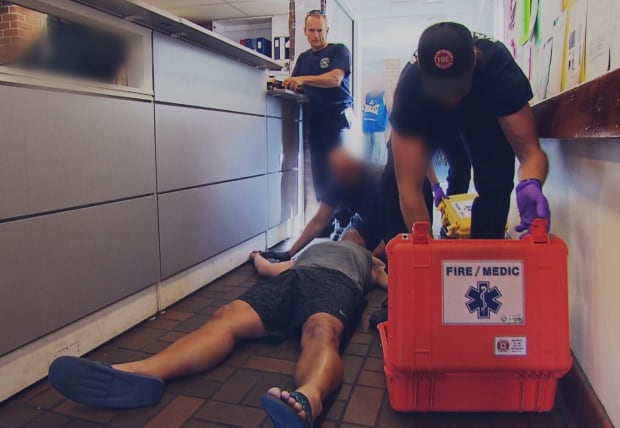Responding to Vancouver’s fentanyl crisis: ‘This is our 10th time doing this today,’ says firefighter
“This is our 10th time doing this today, daily routine for us,” says Vancouver firefighter Jason Lynch.
He’s not talking about knocking down a fire or even rescuing a cat stuck in a tree.
Instead, he’s once again kneeled down trying to revive a drug addict. This one isn’t responding to two doses of opioid antidote naloxone, which goes by the trade name Narcan.

‘Want us to bag him?’ are the first words out of a firefighter’s mouth as he and his colleagues approach an unresponsive man whom paramedics are already working on. (CBC)
Oxygen, pain stimulation (like a knuckle in the rib) and shots of Narcan are the first steps to try to revive a drug user, say the first responders who work out of Vancouver’s fire hall No. 2, one of the busiest in Canada.
But none of those things are working on this man.

Jakubec holds an IV bag while paramedics decide what to try next on an unresponsive man who has overdosed. (CBC)
“You guys are like the pros now,” says a paramedic who arrives on the scene.
“We are,” Lynch responds.
They rarely put out fires anymore, or even ride in the fire trucks.

A paramedic decides to open the patient’s airway through his nose after three doses of Narcan fail to revive him. (CBC)
They are usually first on the scene, in an SUV, responding to medical calls after someone passes out on the street in the city’s Downtown Eastside.
“There it is. Nice work,” says Lynch as the man comes back to life after repeated shots of Narcan. It blocks the effect of opioids like fentanyl, the deadly drug that’s caused a public health emergency in B.C. and threatens to do the same elsewhere across the country.

‘You overdosed. You OD’d buddy,’ says a paramedic who gently helps her patient sit up. (CBC)
This is an especially busy day, the firefighters explain, because it’s when people line up to get their monthly welfare checks.
‘It’s very difficult to see humans in that kind of trauma and situation.’
– Jason Lynch, Vancouver firefighter
“Welcome to Welfare Wednesday in Vancouver,” says firefighter Ryan McConnell, who explains that with all that cash on the street, fentanyl dealers and first responders are both in very high demand.
Overdose deaths from a bootleg version of fentanyl smuggled from Asia are expected to skyrocket across Canada this year.
According to statistics from provincial coroners, opioid overdoses now kill more Canadians than car crashes.
Approximately two people die every day in B.C. from accidental overdoses, and 62 per cent of those cases are linked to fentanyl.
A task force is working on the problem, but it’s the front-line paramedics and firefighters who see the devastation of bootleg fentanyl up close. The powerful painkiller is said to be up to 100 times more potent than morphine or heroin.
- ‘It’s going to take you,’ warns B.C. man who lost brother and girlfriend to fentanyl overdoses?
“It’s very difficult to see humans in that kind of trauma and situation. You’re walking into an alley that’s got a lot of different smells in it — needles, rats, garbage everywhere,” says Lynch, who’s been a firefighter for three years.
Firefighter Jason Lynch responds to as many as 40 overdoses a day0:39
“You just walk by lines of different people shooting up and then you treat the third one on the left, and it’s just a matter of time before the first two go down as well.
“We are putting a small Band-Aid on a big cut.”
By the time they reach their next patient, in a tent city, another addict has already revived her with Narcan.
Free Narcan kits are distributed to any addict who wants one.
“You gave her four shots of Narcan?” Lynch asks.
“Yes,” a man in a neighbouring tent responds.

‘Narcan is going to wear off, and you are just going to OD again,’ Lynch tells a woman who was just revived after an overdose in a tent city in Vancouver’s Downtown Eastside. (CBC)
The young woman is oblivious to her soiled shorts and the thick smell of human waste.
They convince her to go to hospital before the Narcan wears off and she passes out again.
“We need to walk you out to the ambulance,” Lynch tells her. “You don’t have a choice. You are just going to OD as soon as it wears off.”
Lynch tells CBC how he had to revive a 24-year-old girl twice in the same month.
“It wears on you, on your soul.”
Their next patient is a clean-cut, middle-aged man lying on the floor at a homeless shelter.
A staffer has already given him one shot of Narcan, but it didn’t work.

Lt. Doug Conacher of the Vancouver Fire Service looks on as Lynch gets to work on a man who has overdosed and isn’t responding to Narcan. (CBC)
“He had taken fentanyl and was told it was really strong fentanyl and a lot of people were overdosing,” says Lynch, who believes the man was wise to get himself to a Lookout Society shelter before he passed out alone on the street.
Lookout Society, which operates several shelters in Greater Vancouver, decided two years ago to train its staff to handle overdose cases and to keep a supply of Narcan.
Lynch and his team also try to wake him up with pain stimulation — a sternum rub, a knuckle in the rib cage, a trap-squeeze rub of a fingernail.
Still nothing.
Lynch is very concerned a potent batch of fentanyl has hit the streets.
Finally, after 10 minutes and four rounds of Narcan, the man grunts back to life.
“You overdosed … you got to stay up, stay awake man, keep those eyes open,” Lynch tells the patient as he’s loaded into an ambulance.
“I’m not joking, you took a tonne of Narcan,” a nurse says.

‘Narcan warriors’ is what Shane Williams, executive director of the Lookout Society, calls the community workers who routinely administer Narcan to overdose patients and then call 911. (CBC)
Staff at shelters and clinics are the unsung heroes in the fight against fentanyl deaths.
Lookout Society shelter staff have had to administer Narcan 240 times so far this year.
“Each one of those are life-saving interactions that our staff have quite bravely been a part of,” executive director Shane Williams tells CBC.
Narcan is available without a prescription. Community workers, and even drug users themselves, have helped save lives by giving that crucial first dose quickly after an overdose.
“Those are the Narcan warriors, that have just continued to keep people alive long enough in the hopes that they are going to make better choices in the future,” says Williams.

Firefighters Lt. Doug Conacher, Ryan McConnell, Jay Jakubec and Jason Lynch allowed reporter Natalie Clancy and videographer Fred Gagnon to follow them for two shifts in late August. (CBC)
CBC NEWS INVESTIGATES
If you have information on this or any other story we should investigate, email us: [email protected]